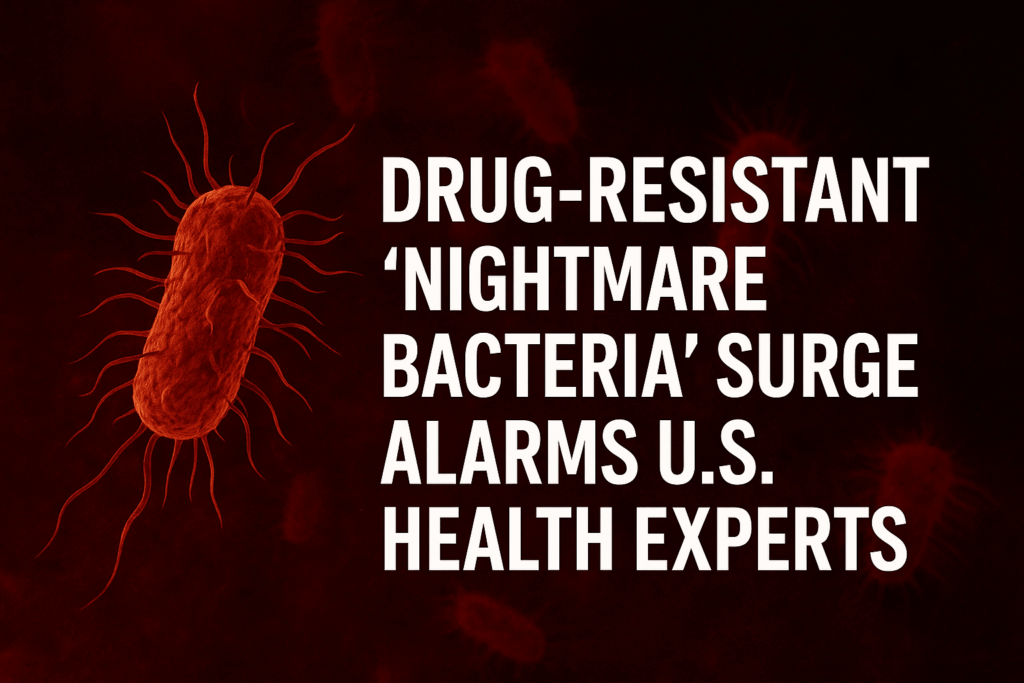U.S. health officials are sounding the alarm after infections from highly drug-resistant bacteria surged nearly 70% between 2019 and 2023, according to new federal data. Scientists fear that many people may carry these bacteria without showing symptoms, thereby raising the risk of undetected community spread.
The Centers for Disease Control and Prevention (CDC) reports that bacteria carrying the New Delhi metallo-β-lactamase, or NDM, gene are driving the sharp increase. These strains are notoriously difficult to treat. Only two antibiotics work against NDM-positive infections. Both must be delivered intravenously and are costly, researchers said.
Once seen mainly in overseas patients, the gene has now gained a foothold in the U.S. “The rise of NDMs in the U.S. is a grave danger and very worrisome,” said David Weiss, an infectious disease researcher at Emory University in Atlanta. Weiss warned that the spread into communities could turn routine medical issues into lasting complications.
The report, published in the Annals of Internal Medicine, compiled data from 29 states that conduct specialized testing for carbapenem-resistant infections. In 2023, 4,341 such cases were identified, out of which 1,831 involved bacteria with the NDM gene. This is a fivefold increase in NDM-positive infections compared to the number seen just a few years earlier.
Overall, the rate of carbapenem-resistant infections climbed from just under 2 per 100,000 people in 2019 to more than 3 per 100,000 in 2023. This marks a 69% increase. But the surge in NDM cases was far more dramatic. Cases jumped from 0.25 per 100,000 to 1.35, a 460% spike.
Carbapenems are a last line of defense for serious infections. Losing their effectiveness leaves doctors with few options. “Infections long considered routine and easy to combat — like urinary tract infections — could become harder to treat,” said CDC researcher Dr. Maroya Walters, a coauthor of the study.
Public health officials explain that antimicrobial resistance, or AMR, develops when bacteria and fungi adapt to survive drugs meant to kill them. The CDC warns that misuse of antibiotics — from not finishing prescriptions to unnecessary prescribing — accelerates resistance.
Some outside experts point to the COVID-19 pandemic as a key driver. “We know antibiotic use surged during the pandemic. This likely led to increased drug resistance,” said Dr. Jason Burnham, an infectious disease specialist at Washington University in St. Louis.
Yet the scope of the crisis may be even larger than the numbers show. The CDC states that many hospitals are unable to conduct advanced genetic resistance tests, and most states have incomplete surveillance systems. Major population centers, such as California, Florida, New York, and Texas, were missing data. Burnham said the nationwide totals are “definitely underestimated.”
The findings build on earlier alerts. In June, the CDC reported a surge in NDM cases in New York City between 2019 and 2024, underscoring that local outbreaks can spread rapidly when detection and control measures are inadequate.
Global health agencies warn that unchecked resistance could usher in a “post-antibiotic era.” In this scenario, common infections could become life-threatening. The World Health Organization calls antimicrobial resistance one of the top 10 global health threats.
U.S. experts say the problem requires more comprehensive testing, improved infection-control programs, and efforts to reduce unnecessary antibiotic use. But with cases already rising fast, the window for containing NDM may be closing.
As Weiss put it, these pathogens are a stark reminder that the fight against superbugs is urgent. Without swift intervention, infections that were once easily treatable may soon become resistant to even the best that modern medicine has to offer.


